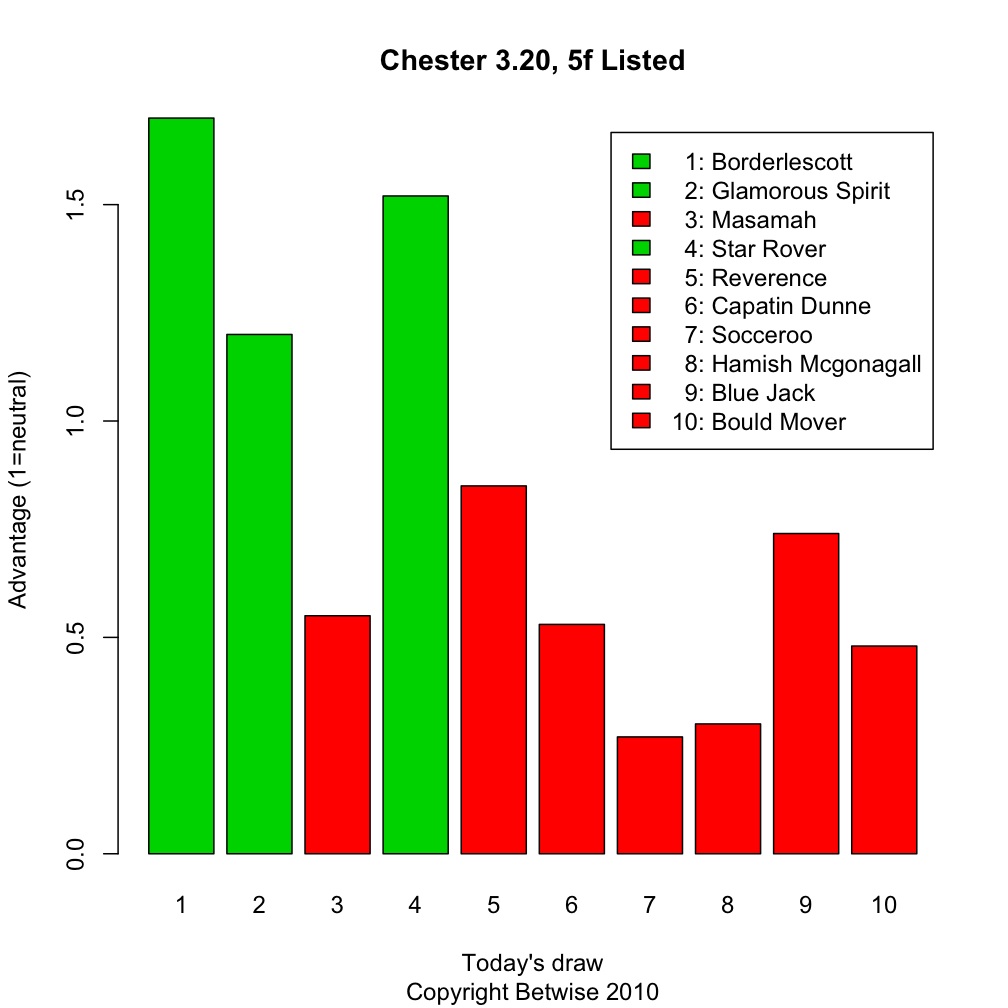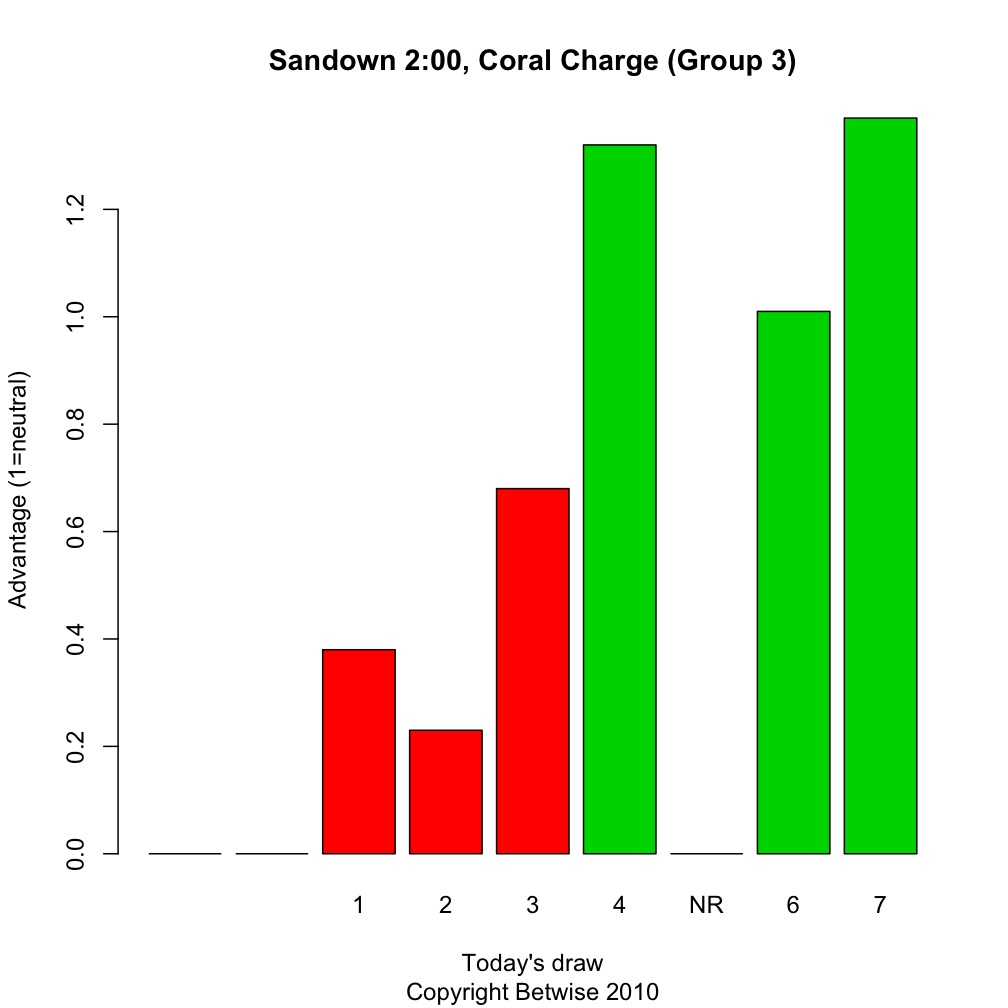Archive for July, 2010
King George value?
Saturday, July 24th, 2010A quick word on the King George.
The credentials of Workforce are there for all to see. Who wouldn’t want to see him to go on and confirm himself as this year’s wonderhorse after his extermely impressive Derby win? But it seems to be forgotten that Cape Blanco beat Workforce in the Dante by over 3 lengths (though Workforce had something of an excuse), and won the Irish Derby last time out. With Workforce likely to start at evens or odds on, and Cape Blanco at 6/1, is there some value in Cape Blanco’s price? What about the older horses? The last 10 years have only seen two 3yr old winners. With some of these older horses still improving, can we be sure this year’s 3yr olds are even good enough?
Well, today we’ll see. Too much to savour to worry about betting.
Saturday sprint leaders
Saturday, July 24th, 2010Today’s lagger and leader statistics, as highlighted in the blog on previous Saturdays, are now online in the Betwise Members’ area. Last week’s top leaders for each race threw up Peppercorn Rent amongst others, purely on the basis of its running characteristics, winning at 16/1 at Ripon.
Newbury Super Sprint
Saturday, July 17th, 2010Newbury, 3.20. Over 20 runners line up for a 5 furlong dash over Newbury’s wide, galloping 5 furlong course for ground on the soft side of good. In case you were expecting one of Betwise’s super draw graphs to accompany the occasion, we’re sorry to disappoint. There just aren’t enough occasions when anything like this many runners line up for a 5 furlong dash at Newbury, let alone on this ground, to make a graph meaningful. In fact, it would likely mislead. If there is any identifiable bias, it is towards the far rail (so with low numbers), but there’s not enough data to state this with certainty. However, we’re somewhat encouraged by Blessed Place’s victory yesterday when it raced alone on the far rail, also.
Front runner statistics are also unlikely to help us much in this race. With so many (fast) runners, it’s sure to be a true test of pace and unlikely that any runner can “steal” the race by getting an early lead. In fact, early pacesetters are liable to set up the race for something with a turn of foot towards the end – especially given that today’s test on the ground may be quite stiff.
What to do in the case of a sprint without any obvious pace or draw angle? Why, look for the fastest horse over the distance, of course. What better statistics to use in this case than the best speed rating for each horse (which we can find in the previous form of each runner in the Smartform database).
There are a few contenders but with previous form on the ground, Ballista and Temple Meads stand out. If indeed there is an advantage to being drawn on the far rail, then Temple Meads, in stall 1, is also well placed to take it. But at 6/1 in a 25 runner field, Temple Meads will already be vying for favouritism with Richard Hannon’s leading hope, Reckless Reward. Both are short enough in price, we think, so Ballista will be better value, especially on the exchanges. However, the draw in 13 is something of an unknown and we have to forgive its last, somewhat below par, run. Of the outsiders, the Smartform speed figures show that Golden Shine is making nice improvement, recording a significantly better rating last time out, and will be an even bigger price on the exchanges.
South Africa v India latest score
Tuesday, July 13th, 2010South Africa take on India in Durban in their Twenty20 match.
Why stall 1 wins at Chester – even when it’s stall 9
Sunday, July 11th, 2010Yesterday’s City Wall Stakes was a fascinating race to watch from many perspectives, and well worth a second look for as long as the video link here holds good. We wrote beforehand about the draw statistics at Chester, which were completely against the eventual winner, Blue Jack, drawn in stall 9. Our favoured runners were drawn 1 and 2, with Glamorous Spirit, in stall 2, the best previous front runner in the race and therefore predicted to lead early.
The prediction was right – Glamorous Spirit set off at a furious pace and quickly led towards the inside rail. However, the pace was indeed furious. Glamorous Spirit must be one of the fastest breaking horses in training. She was also our front-running prediction in the Epsom Dash a few weeks back, when drawn on the unfavoured inside rail there – indeed she did break best, but her poor draw meant her race was quickly over.
In the context of yesterday’s race at Chester, she effectively burned herself out early on, and faded to be last – though even with this explanation, her run was still some way below her best form. (She may be seen to better effect on a straighter track where her early speed will not be blunted, as when winning a valuable race at the Curragh prior to yesterday’s outing – though the trainer seems to think otherwise.)
However, from the perspective of the Chester draw, Blue Jack, the winner, provides us with the most interesting run from this race. There’s no better use for the cliche “the exception that proves the rule” than his run. Blue Jack broke slowly, as indeed our lagger statistics over at the Betwise Members’ area (available until next Saturday) also correctly predicted. Blue Jack was given over a 50% chance of starting the slowest in the race before it began. As the commentator noted, Blue Jack was indeed slowest out of the stalls and “lost a few lengths at the start” – at least in relation to the rest of the field being carted along by Glamorous Spirit. However, Blue Jack’s jockey, Richard Kingscote, used that negative to good advantage and rode a very shrewd race, dropping her in behind the field early and hugging the inside rail position around the Roodee’s tight bends. It’s this position that produces the strong bias to stall 1, with any runner that sticks to the inside rail covering far less ground than those racing wide. The fact that R Kingscote managed to obtain it from stall 9 was a nice bonus. With the pace at which the leaders set off, he was able to let Blue Jack gain momentum in his own time – but the crucial point is that this was done on the inside rail. So “stall 1” wins at Chester, even when it’s stall 9…
Today’s Chester draw bias for each runner
Saturday, July 10th, 2010Chester, our favourite course for demonstrating the effect of the draw, plays host to a nice listed contest over 5 furlongs today in the 3.20.
Some very nice sprinters on display here, but how well will they be able to show their ability? At Chester, more than anywhere else, the inside rail is always the place to be. We’ve written about this well known bias on a number of other occasions, especially in terms of spotting front runners whose superior early speed can get them to the inside rail spot early.
In Racing Ahead this month, we go further by quantifing the draw effect in general, to give punters a handle on exactly what advantage there is. Combined with front runner ratings over at the Betwise members’ area, the draw often presents the best chance of understanding what will influence the race outcome most over the minimum distance – outside a horse’s natural ability and form.
However, the picture is not “one size fits all” – field size makes a difference. So let’s have a look at the bias by stall, tailored for the field at Chester today using our Smartform draw model:
Whilst stall 1 (against the inside rail) comes out best over field sizes of 10, the advantage is not as pronounced as in larger fields, and, ability aside, does not reflect the current price differential between Borderlescott and Glamorous Spirit, drawn just to its outside. Now, which of the two has a better chance of breaking early? Head over to the Betwise Members’ area and find out.
Draw analysis at Sandown today
Saturday, July 3rd, 2010As per last Saturday’s post we shift our attention in July to assessing the effect of the draw in upcoming races. To do this we are using an automated model created with Smartform, applying the principles laid out in the Betwise article in this month’s Racing Ahead.
Focus today is on the first race at Sandown, which requires analysis of the 5 furlong straight course in the middle of the track. As with front runners, draw bias tends to show up in results most strongly at races under a mile. Although there are notable exceptions to this rule (as with the case of the Ebor draw bias over 1 mile 6 furlongs at York), it usually pays to concentrate on sprint distances.
Sandown exposes a weakness in some draw analysis you can find, which is to concentrate on strike rate per stall, without factoring in stall positions. You can read a lot more about this in our article, but sticking with the case of Sandown, as any regular Sandown racegoer knows, the stalls are usually positioned with the highest number against the far rail and represent a position – though not necessarily a stall! – that has held a continuing advantage over the years. The actual stall number drawn against the far rail varies according to the size of the field, making strike rate per stall statistics more or less redundant. The way to overcome this is to use historic data to map the advantage of the position on the track which each stall occupied (though even here, there are always problems presented by rail movements).
Our Smartform model above maps the previous advantage of each course position onto all today’s stall numbers, as if you are looking overhead at the race about to start – stall 7 is drawn against the far rail. The height of the bar represents stall advantage, with anything over 1 indicating higher than expected winners and under 1 a negative expectation. (Stall 5 should be empty today due to the withdrawal of Wi Dud – draw 4 may be shifted one up as a result).
What conclusions to draw from this? Though we can see immediately that the draw advantage in small fields does not exclude the possibility of any runner winning, there is a distinct negative from being drawn in stalls 1, 2 and 3. Combined with front runner analysis, we can also see which, if any, of these contenders are able to break early to secure a better position (front runner analysis for this race is posted in the Betwise Members’ area and freely available). Going back to the commonly held belief that the highest stall is the place to be at Sandown, we can see that whilst this is born out by our Smartform model, it is very marginal for small fields, and there is, for example, almost as big an advantage being drawn in stall 4 today. So is Bould Mover, in stall 4, better value than Triple Aspect, the hot favourite drawn on the far rail in stall 7? Does Reignier, in stall 3, represent value at 14/1, given that stall 3 still produces a reasonable number of winners in small fields? Of course, answering these questions relies on far more than knowing the runners’ stall position – we need to know more about the ability of the horses concerned, but at least we can now put the effect of the draw in its place.


